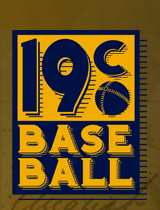Playing Rules
of the
American Association
of
Base Ball Clubs, 1884.
ADOPTED IN PURSUANCE OF ARTICLE IX OF THE AMERICAN ASSOCIATION CONSTITUTION.
CLASS I. THE MATERIALS OF THE GAME.
Rule 1. The Ground must be an inclosed field, sufficient in size to enable each player to play in his position as required by these Rules.
Rule 2. The Infield must be a space of ground thirty yards square.
Rule 3. The Bases must be
- Four in number, and designated as First Base, Second Base, Third base, and Home Base.
- The Home Base must be of white marble or white stone, twelve inches square, so fixed in the ground as to be even with the surface, and so placed in a corner of the infield that two of its sides will form part of the boundaries of said infield.
- The First, Second and Third Bases must be canvas bags, fifteen inches square, painted white, and filled with some soft material, and so placed that the centre of each shall be upon a separate corner of the infield, the First Base at the right hand, the Second Base opposite, and the Third Base at the left of the Home Base.
- All the Bases must be securely fastened in their positions, and so placed as to be distinctly seen by the Umpire.
Rule 4. The Foul Lines must be drawn in straight lines from the outer corner of the Home Base through the center of the positions of the First and Third Bases, to the boundaries of the ground, and a line shall be laid down from First Base 45 feet in length towards the Home Base and three feet outside the Foul Lines.
Rule 5. The Pitcher's Line must be straight lines forming the boundaries of a space of ground in the infield six feet long by four feet wide, distant fifty feet from the center of the Home Base, and so placed that the six feet lines would each be two feet distant from and parallel with a straight line passing through the centre of the Home Base and Second bases. Each corner of this space must be marked by a flat iron plate or stone six inches square, fixed in the ground even with the surface.
Rule 6. The Catcher's Line must be drawn from the outer corner of the Home Base, in continuation of the Foul Lines, straight to the limits of the ground back of the home Base.
Rule 7. The Captain's Lines must be drawn from the Catcher's Lines to the Limits of the ground, fifteen feet from and parallel with the Foul Lines.
Rule 8. The Player's Lines must be drawn from the Catcher's lines to the Limits of the ground, fifty feet from and parallel with the Foul Lines.
Rule 9. The Batsman's Lines must be straight lines forming the boundaries of a space on the right, and of a similar space on the left of the Home base, six feet long by three feet wide, extending three in front of and three feet behind the centre of the Home Base, and with its nearest line distant one foot from the Home Base.
Rule 10. The Lines designated in Rules, 4, 5, 6, 7, 8, and 9 must be marked with chalk or other suitable material, so as to be distinctly seen by the Umpire. They must all be so marked their entire length, except the Captain's and the Player's Lines, which must be so marked for a distance of at least thirty-five yards from the Catcher's Lines.
Rule 11. The Ball
- Must weigh not less than five nor more than five and a quarter ounces, avoirdupois. It must measure not less than nine nor more than nine and a quarter inches in circumference. It must be manufactured using the Patent Plastic Composition, under the specifications and proposition made by A.J. Reach, and adopted by the Association, and a ball made according to the specifications, and stamped, "American Association," and guaranteed shall be the only ball lawful for use in all games in the American Association between American Association clubs; and further, that no other ball shall be legal during 1884, 1885, and 1886.
- Each ball to be used in championship games shall be examined, measured and weighed by the Secretary of the Association, enclosed in a paper box and sealed with the seal of the Secretary, which seal shall not be broken except by the umpire in the presence of the captains of the two contesting nines after play has been called.
- In all games the ball or balls played with shall be furnished by the home Club, and become the property of the winning club.
- Should the ball become out of shape, or cut, or ripped so as to expose the yarn, or in any way so injured as to be unfit for fair use, a new ball shall be called for by the umpire at the end of an even innings,
- Should the ball be lost during the game, the Umpire shall, at the expiration of five minutes, call for a new ball.
Rule 12. The Bat
- Must be made wholly of wood.
- It must be round; must not exceed two and one half inches in diameter in the thickest part, and must not exceed forty-two inches in length.
The Rules: 1884 American Association of Base Ball Clubs Continued ![]()
The Rules of the Game: A Compilation of the Rules of Baseball 1845–1900 ![]()

